Road signs in Iran are regulated in the INSO 14815-1 standard.[1] They generally follow the Vienna Convention on Road Signs and Signals.
Road signs are divided in three categories:
- Regulatory signs;
- Warning signs;
- Information signs.
Iran signed the Vienna Convention on Road Signs and Signals on November 8, 1968 and ratified it on May 21, 1976.[2]
![]() Freeways
Freeways
![]() Roads and Expressways
Roads and Expressways
. Cities
![]() or
or ![]() Temporary signs such as detours and construction sites
Temporary signs such as detours and construction sites
Warning signs
 Warning for bends
Warning for bends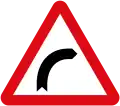 Bend to the right
Bend to the right Bend to the left
Bend to the left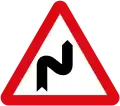 Double bend, first to the right
Double bend, first to the right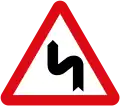 Double bend, first to the left
Double bend, first to the left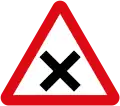 Junction
Junction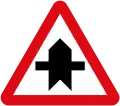 Crossroad with priority
Crossroad with priority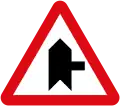 Side road with priority from the right
Side road with priority from the right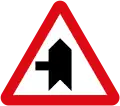 Side road with priority from the left
Side road with priority from the left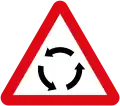 Roundabout
Roundabout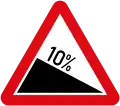 Dangerous descent (10%)
Dangerous descent (10%)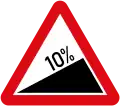 Dangerous climb (10%)
Dangerous climb (10%)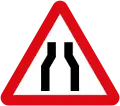 Road narrows (both sides)
Road narrows (both sides)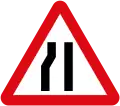 Road narrows (right side)
Road narrows (right side)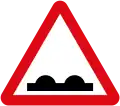 Uneven road
Uneven road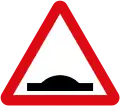 Caution, speed bump
Caution, speed bump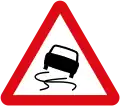 Danger of skidding
Danger of skidding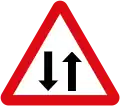 Two-way traffic
Two-way traffic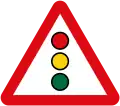 Traffic light
Traffic light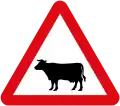 Animals (domesticated)
Animals (domesticated)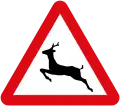 Wild animals
Wild animals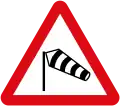 Crosswind
Crosswind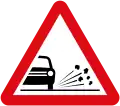 Loose gravel
Loose gravel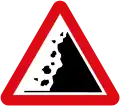 Rockfall
Rockfall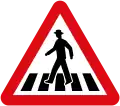 Pedestrian crossing ahead
Pedestrian crossing ahead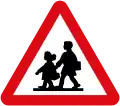 Children
Children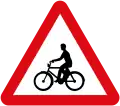 Caution for bicyclists
Caution for bicyclists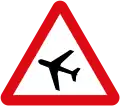 Aircraft (landing corridor above road)
Aircraft (landing corridor above road)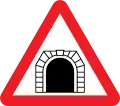 Caution, tunnel
Caution, tunnel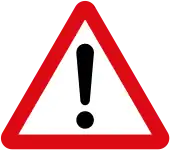 Other hazard
Other hazard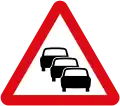 Caution, queues likely
Caution, queues likely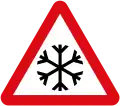 Be careful in winter
Be careful in winter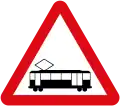 Tramway
Tramway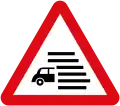 Caution, fog likely
Caution, fog likely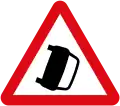 Caution, accident black spot
Caution, accident black spot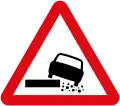 Soft verge
Soft verge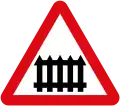 Level crossing with gates or barriers
Level crossing with gates or barriers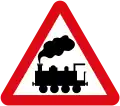 Level crossing without gates or barriers
Level crossing without gates or barriers Distance marker (150 m)
Distance marker (150 m) Distance marker (100 m)
Distance marker (100 m) Distance marker (50 m)
Distance marker (50 m) Warning, single-track railway crossing
Warning, single-track railway crossing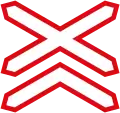 Warning, multiple-track railway crossing
Warning, multiple-track railway crossing
Priority signs
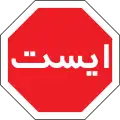
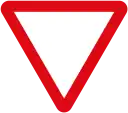 Yield
Yield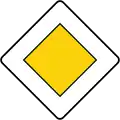 Priority road
Priority road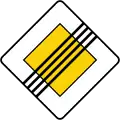 End of priority road
End of priority road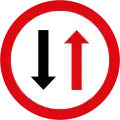 Priority before the oncoming traffic
Priority before the oncoming traffic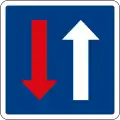 Priority of the oncoming traffic
Priority of the oncoming traffic
Prohibitive or restrictive signs
 Road closed to all vehicles in both directions
Road closed to all vehicles in both directions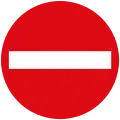 No entry
No entry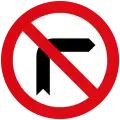 No right turn
No right turn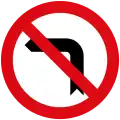 No left turn
No left turn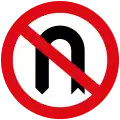 No U-turn
No U-turn No cars
No cars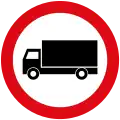 No lorries
No lorries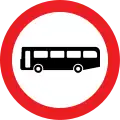 No buses
No buses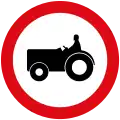 No tractors
No tractors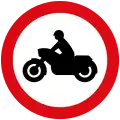 No motorcycles
No motorcycles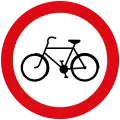 No cycling
No cycling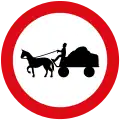 No animal-drawn vehicles
No animal-drawn vehicles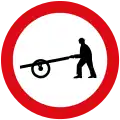 No handcarts
No handcarts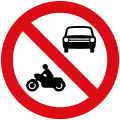 No motor vehicles
No motor vehicles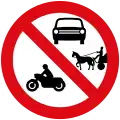 No entry for motorised or animal-drawn vehicles
No entry for motorised or animal-drawn vehicles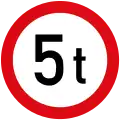 No vehicles heavier than indicated
No vehicles heavier than indicated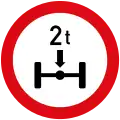 No vehicles with axle weight greater than indicated
No vehicles with axle weight greater than indicated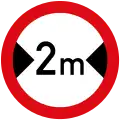 No vehicles wider than indicated
No vehicles wider than indicated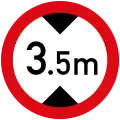 No vehicles taller than indicated
No vehicles taller than indicated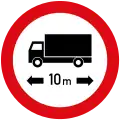 No vehicles or combinations longer than indicated
No vehicles or combinations longer than indicated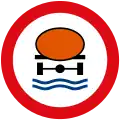 No vehicles carrying hazardous cargo
No vehicles carrying hazardous cargo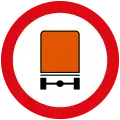 No vehicles carrying water-polluting cargo
No vehicles carrying water-polluting cargo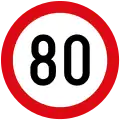 Speed limit (80 km/h)
Speed limit (80 km/h)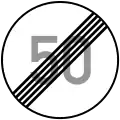 End of speed limit
End of speed limit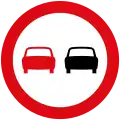 No overtaking
No overtaking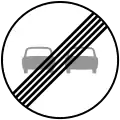 End of no-overtaking zone
End of no-overtaking zone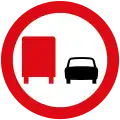 No overtaking by lorries
No overtaking by lorries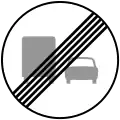 End of no-overtaking zone for lorries
End of no-overtaking zone for lorries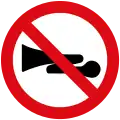 No use of audible warning signals
No use of audible warning signals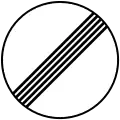 End of all prohibitions
End of all prohibitions Stop to pay toll duty
Stop to pay toll duty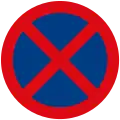 No stopping
No stopping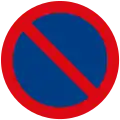 No parking
No parking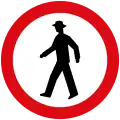 No pedestrians
No pedestrians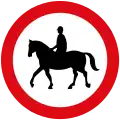 No animal riders
No animal riders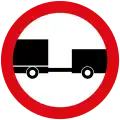 No vehicles towing trailers
No vehicles towing trailers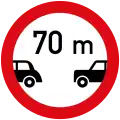 Safe distance (70 m)
Safe distance (70 m)
Mandatory signs
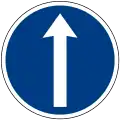 Ahead only
Ahead only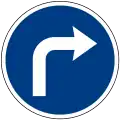 Turn right ahead
Turn right ahead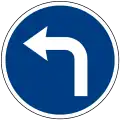 Turn left ahead
Turn left ahead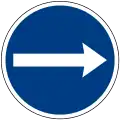 Turn right here
Turn right here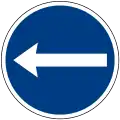 Turn left here
Turn left here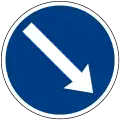 Keep right
Keep right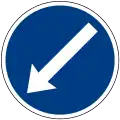 Keep left
Keep left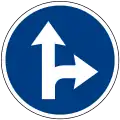 Ahead or right only
Ahead or right only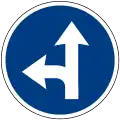 Ahead or left only
Ahead or left only One way
One way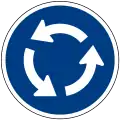 Roundabout
Roundabout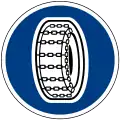 Snow chains compulsory
Snow chains compulsory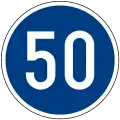 Minimum speed limit
Minimum speed limit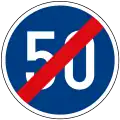 End of minimum speed limit
End of minimum speed limit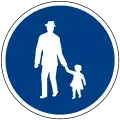 Pedestrian zone
Pedestrian zone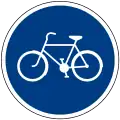 Cycleway
Cycleway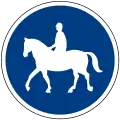 Route for animal riders (bridleway)
Route for animal riders (bridleway)
Traffic regulation
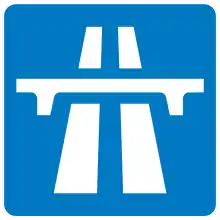 Freeway marker
Freeway marker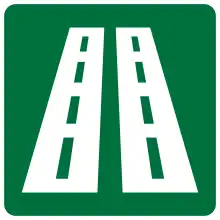 Expressway marker
Expressway marker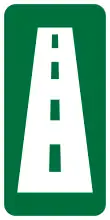 Road marker
Road marker Street marker
Street marker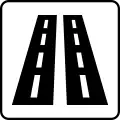 Avenue and boulevard marker
Avenue and boulevard marker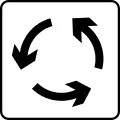 Roundabout marker
Roundabout marker Sign ahead plaque (200 m, on top of the all signs)
Sign ahead plaque (200 m, on top of the all signs) Sign ahead plaque (2 km, on top of the all signs)
Sign ahead plaque (2 km, on top of the all signs)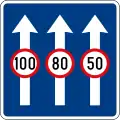 Different speed limitations in several roads
Different speed limitations in several roads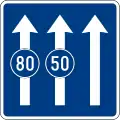 Minimum speed in different lanes
Minimum speed in different lanes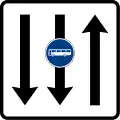 Bus lane ahead
Bus lane ahead Vehicles carrying hazardous cargo turn left
Vehicles carrying hazardous cargo turn left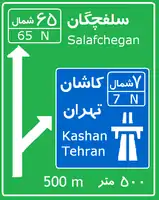 Directional sign
Directional sign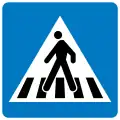 Pedestrian crossing
Pedestrian crossing
Temporary signs
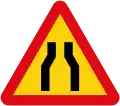 Road narrows (both sides)
Road narrows (both sides)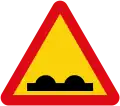 Uneven road
Uneven road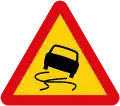 Danger of skidding
Danger of skidding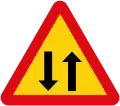 Two-way traffic
Two-way traffic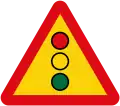 Traffic light
Traffic light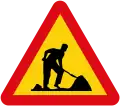 Roadworks
Roadworks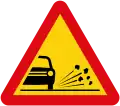 Loose gravel
Loose gravel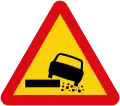 Soft verge
Soft verge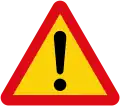 Other dangers
Other dangers
Route shields
 Freeway
Freeway Highway
Highway
References
- ↑ "استاندارد-ملی-علائم-14815-1" (PDF). imentaraddod.com (in Persian). 2013.
- ↑ "United Nations Treaty Collection". treaties.un.org. Retrieved 2023-11-21.
This article is issued from Wikipedia. The text is licensed under Creative Commons - Attribution - Sharealike. Additional terms may apply for the media files.